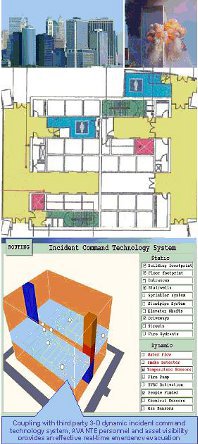Key Patented and Pending Capabilities Enable AVANTE RFID Personnel and Asset Visibility System (PAVS)
AVANTE RFID Personnel and Asset Visibility System (PAVS) incorporates our patent-pending active RFID dynamic “ZONING” technology for real-time locating upon demand. This feature can be initiated by the badge bearers or by the system administrator in case of massive emergency. However, when not in emergency, the system must maintain security but not invade the privacy of individuals.
PERSONNEL VISIBILITY DURING NORMAL CONDITIONS:
- Under normal operation, an individual carries a key fob or ISO card size personnel badge. This AVANTE ZONER™ badge contains a passive secured memory chip based on ISO 14443 to provide access control to doors and gates. Traditional Wiegand signals and communication protocols are used to ensure maximum compatibility with any existing legacy systems.
- This AVANTE PAVS badge also has an active RFID chip that either beacons or responds to polling from a nodal short range RELAYER monitor at very low power every second. At such low power level of beaconing and polling, the signal has a read range of approximately 10-20 ft to provide nodal based monitoring of a bearer’s activities within a large area within the nodes such as within a specific floor.
- AVANTE ZONER™ active tag ID numbers are encrypted with a “randomized cyclic number set” and contain no individual personnel data to prevent outside eavesdropping. Fully redundant and synchronized data for both the system server and emergency system are included.
- A nodal based monitoring network of AVANTE RELAYER™ reader stations are judicially located to monitor key activities such as outside doors of buildings. In some areas, nodal monitors may be placed in each floor or even hall entrances and exits.
- These nodal RELAYER™ reader monitors also poll at low power signal strength to limit their monitoring area.
- Real-time locating system (RTLS) monitoring network of AVANTE RELAYER™ are a second layer of monitoring stations that are normally in standby mode only. They are always in standby listening mode. The RTLS has a high sensitivity and stations are typically placed approximately 150 feet apart inside a building and 450 feet apart in an open area.
- Most of the monitoring RELAYER™ communicate with wired Ethernet whenever possible. WiFi communication can be used to supplement locations that are particularly remote.
PERSONNEL VISIBILITY DURING EMERGENCY CONDITIONS:
In a campus environment, emergencies can be individual and include accidents, personal illnesses, thefts or attacks. Emergencies can also be group-based, such as occurring within the room of a floor, building, etc. At times, emergencies apply to the whole population of a campus.
- When an individual encounters danger or is involved in an accident, the individual can press on the “panic” switch of their personnel badge (either in the ISO card or standard key fob form-factors) to change the badge operation from its lower power transmission to higher power. When such signals are sent, the RTLS monitoring station will use such signals and “received signal strength indicator” (RSSI) to deduce the bearer’s physical location. Help and assistance will be dispatched accordingly.
- When in a mass emergency such as a fire or in other emergency recquiring evacuation, many of the “panic buttons” will be activated and the RTLS network of RELAYER™ monitors will be activated and keep track of all tags that have been activated.
- In case of a recognized massive emergency such as a fire or other emergency recquiring evacuation, the RTLS will send out a signal to “command” all tags within its monitoring area to respond in its highest power of transmission so that the system can track everyone within its monitoring area.
- This patent-pending “dynamic zoning on demand” is key for the system to provide visibility in real-time in case of emergency and provides adequate security with privacy under normal operational conditions.
PERSONNEL VISIBILITY DURING EVACUATION CONDITIONS:
Depending on the nature of the emergency, a building evacuation can be chaotic. Many openings to the outside may be used as emergency exits. In extreme cases, there may be portions of a building that are physically destroyed or cut-off from landline connections. In an emergency within a building, any egress control such as turnstile systems might be turned off. All exits are setup to be as unencumbered as possible. Any emergency evacuation tracking system cannot encumber evacuees. Given these considerations, the AVANTE personnel and asset visibility system and system configuration must reflect the following performance criteria:
- Non-obtrusive and non-intrusive.
- Survivability over and beyond typical communication and IT infrastructures.
- High availability and independence from other IT infrastructures.
- Synchronized real-time personnel entry and exit data at local and central systems.
- Redundancy, portability, and independence of the local system to the central system.
- Ease of use and mobility for emergency management staff.
The emergency evacuation tracking and management portion of the AVANTE personnel and asset visibility system is intended to work independently of all existing personnel identification and tracking systems. It is designed to work in conjunction with existing or legacy systems. The evacuation management portion of the new system will function as a stand-alone. The system architecture provides practically unlimited scalability. AVANTE PAVS is designed to handle large multi-level infrastructures with appropriate redundant and portable capabilities.
During normal operation, personnel entering and exiting a facility through identified egress points will be visible in real-time and noted as present or absent. This capability includes the visibility of visitors who will be registered by the guard station and issued the same RFID badge during their visit. Visibility is provided with close to 100% read-rate readers located at all of the egresses of the facility. The AVANTE RFID portals located at each entrance/egress will be either active or passive RFID depending on the locations’ specific requirements.
During an emergency evacuation, the exodus of personnel from the facility will be tracked as long as the system functions. This real-time data from AVANTE PAVS will be used to help locate those personnel or assets remaining in the facility at specific nodal positions as long as the system is functioning. When an emergency occurs, the current building personnel occupancy roster will be noted and available for use in accounting during the evacuation. Outside designated or ad hoc evacuation assembly areas will be equipped with mobile readers and computer systems where evacuees will be electronically registered once clear of the building. These short-range RFID readers may be active or passive depending on specific requirements.
Specific areas-of-refuge (such as inside stairwells or other fortified safety-enhanced areas) could be equipped with similar entrance/egress portals for positive and automatic registering of those personnel entering or leaving the protected areas. The real-time synchronized data will be recorded and maintained for use with any legacy tracking and reporting system. If such areas-of-refuge are used, they can further assist emergency personnel in locating and evacuating building occupants.
During normal operations, landlines are used whenever possible to connect all PAVS monitoring devices (typically Ethernet and optional RS 485 or RS 232) to mobile or fixed site local computers in each zone. Traditional LAN/WAN may be used to link local computers to the central system for total visibility. These local computers in each zone can cover multiple (up to 32) portals and may be mobile and portable to facilitate ease of retrieval in case of emergency.
Availability and survivability may be further enhanced with special fire-retardant sleeves, tubes or other protective conduits. Wireless communications between devices may be used in special circumstances but is not recommended.
Each of the local (preferably mobile) computers is replicated with data from the central server as part of the redundancy protection. Upon signal of an emergency or loss of the landline connection, any one of the mobile computers can be used to account for the current building roster as the starting point to track the evacuation. The mobile computers may be configured to communicate using wired or wireless means with the central server or each other, in the case that the server is not available.
Designated and trained personnel will take one of the mobile computers to the chosen evacuation assembly area. At the assembly areas, personnel would be registered by a RFID badge read and list lookup. Updating of reported personnel against the roster provides a “real-time” list of individuals needing to evacuate. Each mobile computer will communicate personnel evacuation registration updates with the server and/or other mobile computers.
The system will progressively reduce the list of personnel in the building to a point where emergency personnel can isolate the remaining individuals for a final evacuation of the building and evacuation areas. Portals situated in each room or corridor inside the facilities will provide a detailed position of any staff or visitors still inside the facilities. The last available data for each of the nodal zones will be used in combination with the evacuated personnel list to provide better locating of the personnel still needing to be evacuated.



